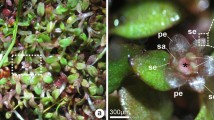Abstract
Anthocyanin is the principal pigment in flowers, conferring intense red-to-blue cyanic colours on petals and helping to attract pollinators. Its biosynthesis involves glycosylation steps that are important for the stability of the pigment and for its aqueous solubility in vacuoles1,2. Here we describe anthocyanin biosynthesis in roses (Rosa hybrida), which is unlike the pathway used in other flowers in that it relies on a single enzyme to achieve glycosylation at two different positions on the precursor molecule. Phylogenetic analysis also indicates that this previously unknown glucosyltransferase enzyme may be unique to roses, with glycosylation having apparently evolved into a single stabilizing step in other plants.

Similar content being viewed by others
References
Strack, D. & Wary, V. in The Flavonoids. Advances in Research Since 1986 (ed. Harborne, J. B.) 1–22 (Chapman & Hall, London, 1993).
Heller, W. & Forkmann, G. in The Flavonoids. Advances in Research Since 1986 (ed. Harborne, J. B.) 499–535 (Chapman & Hall, London, 1993).
Gudin, S. in Encyclopedia of Rose Science (eds Roberts, A. V., Debener, T. & Gudin, S.) 1, 25–30 (Elsevier, Amsterdam, 2003).
Cairns, T. in Modern Roses XI: The World Encyclopedia of Roses (Academic, San Diego, 2000).
Jay, M. et al. in Encyclopedia of Rose Science (eds Roberts, A. V., Debener, T. & Gudin, S.) 1, 248–255 (Elsevier, Amsterdam, 2003).
Tanaka, Y., Katsumoto, Y., Brugliera, F. & Mason, J. Plant Cell Tiss. Organ Culture 80, 1–24 (2005).
Holton, T. A. & Cornish, E. C. Plant Cell 7, 1071–1083 (1995).
Springob, K., Nakajima, J., Yamazaki, M. & Saito, K. Nat. Prod. Rep. 20, 288–303 (2003).
Ogata, J., Itoh, Y., Ishida, M., Yoshida, H. & Ozeki, Y. Plant Biotechnol. 21, 367–375 (2004).
Yamazaki, M. et al. J. Biol. Chem. 274, 7405–7411 (1999).
Author information
Authors and Affiliations
Corresponding author
Ethics declarations
Competing interests
The authors declare no competing financial interests.
Supplementary information
Rights and permissions
About this article
Cite this article
Ogata, J., Kanno, Y., Itoh, Y. et al. Anthocyanin biosynthesis in roses. Nature 435, 757–758 (2005). https://doi.org/10.1038/nature435757a
Published:
Issue Date:
DOI: https://doi.org/10.1038/nature435757a
- Springer Nature Limited
This article is cited by
-
Metabolic profile and transcriptome reveal the mystery of petal blotch formation in rose
BMC Plant Biology (2023)
-
Integrated metabolome and transcriptome analysis of the anthocyanin biosynthetic pathway in relation to color mutation in miniature roses
BMC Plant Biology (2021)
-
Isolation of PlANS and PlDFR genes from herbaceous peony (Paeonia lactiflora Pall.) and its functional characterization in Arabidopsis and tobacco
Plant Cell, Tissue and Organ Culture (PCTOC) (2020)
-
In the name of the rose: a roadmap for rose research in the genome era
Horticulture Research (2019)
-
Complementary iTRAQ-based proteomic and RNA sequencing-based transcriptomic analyses reveal a complex network regulating pomegranate (Punica granatum L.) fruit peel colour
Scientific Reports (2018)





